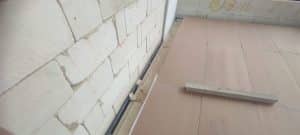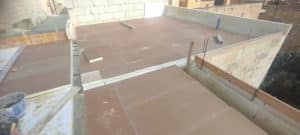If you’re renovating your home or business in Malta, you’ve probably come across microcement—a seamless, modern surface that’s as practical as it is stylish. But among the many questions homeowners and designers ask, one pops up more often than you’d think: is microcement heat resistant?
The short and satisfying answer is yes. Microcement is not only resistant to heat but is actually one of the most versatile materials you can use in both indoor and outdoor settings across Malta’s warm Mediterranean climate.
In this post, we’ll explore five compelling reasons why microcement stands up to heat, why that matters for your home or project, and how to make the most of this material whether you’re updating a kitchen, fireplace, terrace, or commercial space.
Let’s dive in.
1. Microcement Withstands High Temperatures Without Cracking| Is Microcement Heat Resistant
One of the biggest concerns people have when it comes to materials and heat is expansion and cracking. Traditional materials like tiles, wood, and even concrete can expand, warp, or crack under high heat.
But not microcement.
When professionally applied, microcement includes a flexible base layer that allows the surface to adapt slightly to temperature fluctuations. The top layers—composed of high-performance cement, resins, pigments, and sealers—form a cohesive, durable coating that resists thermal shock.
This is especially useful in settings like:
Around fireplaces or stovetops
Outdoor kitchens
Sun-drenched terraces and pool decks
Heated flooring systems
So, if you’re wondering, is microcement heat resistant enough for a Mediterranean summer or a fireplace surround? The answer is a confident yes.
And it’s not just a claim—it’s backed by performance in real-world scenarios. Microcement has been widely adopted in commercial kitchens, spas, and public facilities, all of which require heat-tolerant materials that don’t degrade over time.
2. Perfect Pairing with Underfloor Heating| Is Microcement Heat Resistant
Malta may be sunny for most of the year, but during the cooler months, many homeowners are now turning to underfloor heating systems to keep spaces cozy and energy-efficient.
The great news? Microcement is an ideal match.
Why?
It’s thin (just 2–3mm), allowing heat to rise quickly and evenly through the surface.
It’s thermally conductive, ensuring efficient energy transfer.
It resists heat damage, so it won’t crack or degrade over time.
This makes microcement a smart choice if you’re renovating a villa in Gozo or upgrading a commercial space in Valletta. Pairing it with underfloor heating creates a sleek, modern look without sacrificing comfort.
It’s also worth noting that microcement is lighter than poured concrete or stone, making it a practical solution for apartments or buildings with weight limitations.
If you’re planning an underfloor heating install, or want help choosing materials, we’re here to help. Contact us at Kibitec and our team will walk you through all your options.
3. Great for Outdoor Use in Malta’s Climate| Is Microcement Heat Resistant
Malta’s Mediterranean climate means hot summers, strong sun exposure, and mild winters. Materials used outdoors need to be able to cope with heat, UV rays, and sudden temperature changes—especially on terraces, rooftops, balconies, and poolside areas.
Microcement is up for the challenge.
Thanks to its UV-resistant sealers and heat-resilient composition, it performs extremely well outdoors. It won’t fade, bubble, or peel under prolonged sun exposure. Even when temperatures soar into the 30s or 40s (Celsius), microcement surfaces maintain their integrity.
In outdoor kitchens, microcement can be applied to countertops, cabinets, and even BBQ surrounds without worry. It resists direct heat from appliances and warm surfaces without damage—something not all decorative coatings can claim.
Plus, its waterproof qualities (when sealed correctly) make it the go-to surface for splash zones, pool edges, or garden showers.
So if you’re asking, is microcement heat resistant enough to survive a Maltese summer?—the answer is again: absolutely.
4. Safe and Stylish Around Fireplaces and Stovetops| Is Microcement Heat Resistant
Whether you’re designing a minimalist wood-burning stove surround or a polished concrete-look kitchen backsplash, microcement is both safe and stunning in high-heat areas.
Because of its resistance to heat and fire, microcement is a popular choice for:
Fireplace surrounds
Chimney breasts
Kitchen backsplashes
Wall panels behind stoves or cookers
Unlike wood or plastic-based finishes, microcement doesn’t melt, blister, or ignite under typical fireplace or cooking heat. And unlike tile, there are no grout lines to trap soot or grease—just a smooth surface that’s easy to clean with soap and water.
That said, it’s important to distinguish between heat-resistant and heatproof. Microcement is heat resistant for everyday applications, but you should still avoid placing pots or pans directly from a stovetop onto an unprotected microcement surface. Use trivets or coasters to extend the lifespan of your finish.
If you want guidance on how to make microcement work around fireplaces or appliances in your Malta property, we’ve got you covered. Get in touch with us at Kibitec for tailored advice.
5. Long-Term Durability and Low Maintenance| Is Microcement Heat Resistant
One of the strongest arguments for using microcement in heat-exposed spaces is its longevity.
Once applied and sealed, it forms a hardwearing, flexible, and waterproof surface that holds up under intense use and environmental exposure. In fact, it’s commonly used in the construction industry for its reliable performance in high-stress areas.
Here’s why microcement remains a popular choice for Malta homes and businesses:
No need for tile replacements or grout repairs
No fading or surface warping from sun or heat
Simple resealing every few years keeps it like new
Resistant to both heat and humidity
And with a starting cost of around €65 per square metre, it’s a high-value investment compared to natural stone or premium tiles. Add to that the minimal maintenance, and it’s easy to see why more Maltese homeowners are embracing microcement.
What Can You Use Microcement On?| Is Microcement Heat Resistant
Because it adheres well to multiple substrates, microcement can be applied just about anywhere heat might be a factor:
Concrete floors
Walls
Kitchen counters
BBQ units
Outdoor tables
Indoor fireplaces
Shower walls (hot water safe)
Heated floors
In every case, the material retains its form and function, even with repeated exposure to heat and moisture.
Common Myths About Microcement and Heat| Is Microcement Heat Resistant
While microcement is a rising star in interior and exterior design, a few misconceptions still make the rounds. Let’s clear the air on some of the most common myths related to microcement and heat:
❌ Myth 1: Microcement Will Crack from Heat
Truth: When applied correctly, microcement is flexible and heat-resistant. It contains resins and additives that allow for micro-expansion, meaning it won’t crack just because it gets warm. However, as with any material, poor installation or extreme thermal shock (like applying an ice-cold object to a very hot surface) could cause damage. That’s why working with experienced professionals is key.
❌ Myth 2: It’s Only for Indoor Use
Truth: Microcement is widely used outdoors, especially in hot, dry environments like Malta. With the right sealing and UV protection, it handles direct sunlight and heat with ease—making it ideal for terraces, outdoor kitchens, and pool surrounds.
❌ Myth 3: It Can’t Handle Direct Flame or Cooking Heat
Truth: Microcement is heat resistant, not fireproof. It won’t ignite or melt from the heat generated by cooking, but it’s always recommended to avoid placing hot pots or pans directly on the surface. Use heat mats or trivets for extra protection—just like you would with stone or laminate.
How Does Microcement Compare to Other Heat-Resistant Materials?| Is Microcement Heat Resistant
When evaluating whether microcement is the right choice, it’s helpful to compare it against other popular finishes:
| Material | Heat Resistance | Durability | Maintenance | Visual Appeal | Cost (€/m²) |
|---|---|---|---|---|---|
| Microcement | ⭐⭐⭐⭐ | ⭐⭐⭐⭐ | ⭐⭐⭐⭐ | ⭐⭐⭐⭐⭐ | From €65 |
| Ceramic Tiles | ⭐⭐⭐⭐⭐ | ⭐⭐⭐ | ⭐⭐ | ⭐⭐⭐ | €35–€55 |
| Polished Concrete | ⭐⭐⭐⭐ | ⭐⭐⭐⭐ | ⭐⭐⭐ | ⭐⭐⭐⭐ | €50–€90 |
| Granite/Marble | ⭐⭐⭐⭐ | ⭐⭐⭐⭐⭐ | ⭐⭐ | ⭐⭐⭐⭐⭐ | €80–€200 |
| Laminate | ⭐⭐ | ⭐⭐ | ⭐⭐⭐ | ⭐⭐ | €20–€45 |
As you can see, microcement holds its own among more traditional materials in terms of both performance and aesthetics—without the hefty price tag of marble or the brittleness of tile grout.
Frequently Asked Questions: Is Microcement Heat Resistant?| Is Microcement Heat Resistant
✅ Can I use microcement behind my stove?
Yes, microcement is a great choice for kitchen walls and backsplashes. It holds up well behind gas, electric, or induction hobs. Just remember to protect the surface from direct flame exposure and hot pots.
✅ Will microcement fade in direct sunlight?
Not if it’s sealed properly. UV-resistant sealers ensure the pigment in microcement won’t fade, even in Malta’s strong summer sun. We always recommend resealing every few years to maintain that fresh look.
✅ Is it suitable for outdoor BBQ areas?
Absolutely. Microcement works beautifully around outdoor cooking zones and barbecue surrounds. It resists the radiant heat from grills and is easy to clean afterward.
✅ Can microcement be used on countertops?
Yes, but we suggest using trivets and avoiding cutting directly on the surface. While it handles heat well, sharp objects and excessive friction may wear down the seal.
✅ How long does a heat-exposed microcement surface last?
When installed and maintained properly, microcement can last 10–20 years or more—even in high-heat environments. Regular resealing (every 3–5 years) helps extend its lifespan significantly.
Tips for Maintaining Heat-Exposed Microcement| Is Microcement Heat Resistant
Just because microcement is heat-resistant doesn’t mean it should be neglected. Here’s how to keep it performing its best in hot environments:
🧼 Clean regularly: Use pH-neutral soap and warm water to clean. Avoid acidic cleaners or bleach.
🔄 Reseal every 3–5 years: Especially in kitchens or outdoor areas where heat is a regular factor.
🛡️ Use trivets and coasters: This simple habit extends the life of your microcement countertops or cooking zones.
💨 Ensure proper ventilation: This is particularly helpful in kitchens to reduce trapped heat and steam.
🔧 Hire a professional installer: Quality application is key to long-term performance. DIY kits can’t compare to expert craftsmanship.
Microcement: A Game-Changer for Modern Maltese Spaces| Is Microcement Heat Resistant
From traditional townhouses in Mdina to sleek, modern villas in Sliema, microcement is redefining interior and exterior design across Malta. Its minimalist charm, smooth texture, and thermal durability make it a go-to option for:
Kitchen redesigns
Fireplace makeovers
Bathroom upgrades
Outdoor entertaining spaces
High-end retail and hospitality environments
And when clients ask, is microcement heat resistant enough for my needs? — we love being able to answer with a confident yes.
Want Help Choosing or Installing Microcement?
At Kibitec, we don’t just sell microcement—we install, guide, and maintain it. Whether you’re looking to apply it in a heat-prone area like a kitchen, terrace, or near a fireplace, our experienced team ensures a flawless result from start to finish.
We offer:
✅ Custom microcement installations across Malta
✅ Professional-grade heat-resistant sealers
✅ Specialised products for long-term care
✅ Friendly, expert advice tailored to your space
Whether you’re a homeowner, architect, or interior designer, we’re here to help.
👉 Contact us today for a free consultation or to request a custom quote.




